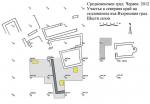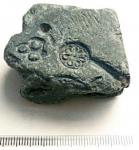Summary (English)
CHERVEN (Stoyan Iordanov – stojan_jo@abv.bg) The northern part of the Inner Town was occupied during the Second Bulgarian Kingdom (12th – 14th centuries) and the first centuries of the Ottoman domination (15th – 16th centuries). Sherds from the 12th – 14th centuries, nails and coins of the Bulgarian King Ivan Alexander (1331 – 1371) were found in a landslide layer in Sector I. Shallow pits were discovered, containing sherds of the 12th – 14th centuries and the 15th – 16th centuries, nails and pieces of charcoal. A building of the 15th – 16th centuries was discovered in Trenches Nos. 23 – 28. It was 10.65 m long, with walls 70 cm wide and built in rubble masonry. The explorations of the cemetery in front of Church No. 13 continued in Trench No. 20A in Sector II. Six burials were discovered and the grave goods comprised glass beads and spherical copper buttons. Grave No. 5 belonged to a man buried in a coffin, as evidenced by carbonized timber remains. The burials were situated at several levels and close to each other. The cemetery was intensively used due to its limited area and appeared before the construction of Church No. 13, since its foundations were built over burials that were discovered. Material from the 12th – 14th centuries was found in the upper layer: iron knives, spurs, fragments from a glass bracelet, glass beads, copper buttons, a copper earring, a bronze finger-ring, a terracotta spindle whorl, a terracotta loom weight, a pot, a stone mould for producing jewelry, nine copper coins, three of which belonged to the Bulgarian King Ivan Alexander with Theodora.
- Stoyan Iordanov - Regional Museum of History – Ruse
Director
Team
Research Body
- Regional Museum of History – Ruse






![Download [PDF]](/excavation/skins/fasti/images/results/download_sml.png)
